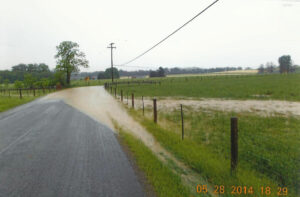Sediment pollution is the single most common source of pollution in U.S. waters. Approximately 30% is caused by natural erosion, and the remaining 70% is caused by human activity. Construction activity is the most common source of sediment pollution. According to the Environmental Protection Agency, sediment pollution causes approximately $16 billion in environmental damage annually.
Sediment pollution can have long-term impacts on aquatic insects, fish and other wildlife in affected waterways. It clouds water so animals cannot see food sources. Suspended particles block light and affect growth of aquatic plants. It settles on the stream bottom and impacts habitat for important aquatic insects– which are a crucial food source in healthy trout streams. Sediment can smother insect larvae and fish eggs and destroy the spawning areas for fish. In the worst cases it can even clog fish gills or kill fish.
In addition to its effects on aquatic plants and animals, sediment can fill streams, lakes and ponds, obstruct waterways and clog storm sewers and ditches. Sediment deposits in rivers can alter the flow of water and reduce water depth making navigation and recreational use more difficult.
What can you do?
The EPA offers the following suggestions for minimizing sediment pollution:
- Instead of hosing them off, sweep sidewalks and driveways
- use weed-free mulch to reseed bare spots on your lawn and if tilling your lawn or garden use compost or straw for erosion control until plants are established
- Notify government officials immediately if you see sediment pollution flowing from a construction site. If it’s in the Yough watershed, please also notify us.
- Allow for buffers of at least 25′ from the edge of streams and creeks and avoid mowing in this area
- Wash your vehicle at commercial car washes or on porous that absorb water like grass or gravel
Local Examples of Sediment Pollution

Sediment-laden water flowing from a construction site on the Mariner East I pipeline in Westmoreland County.




